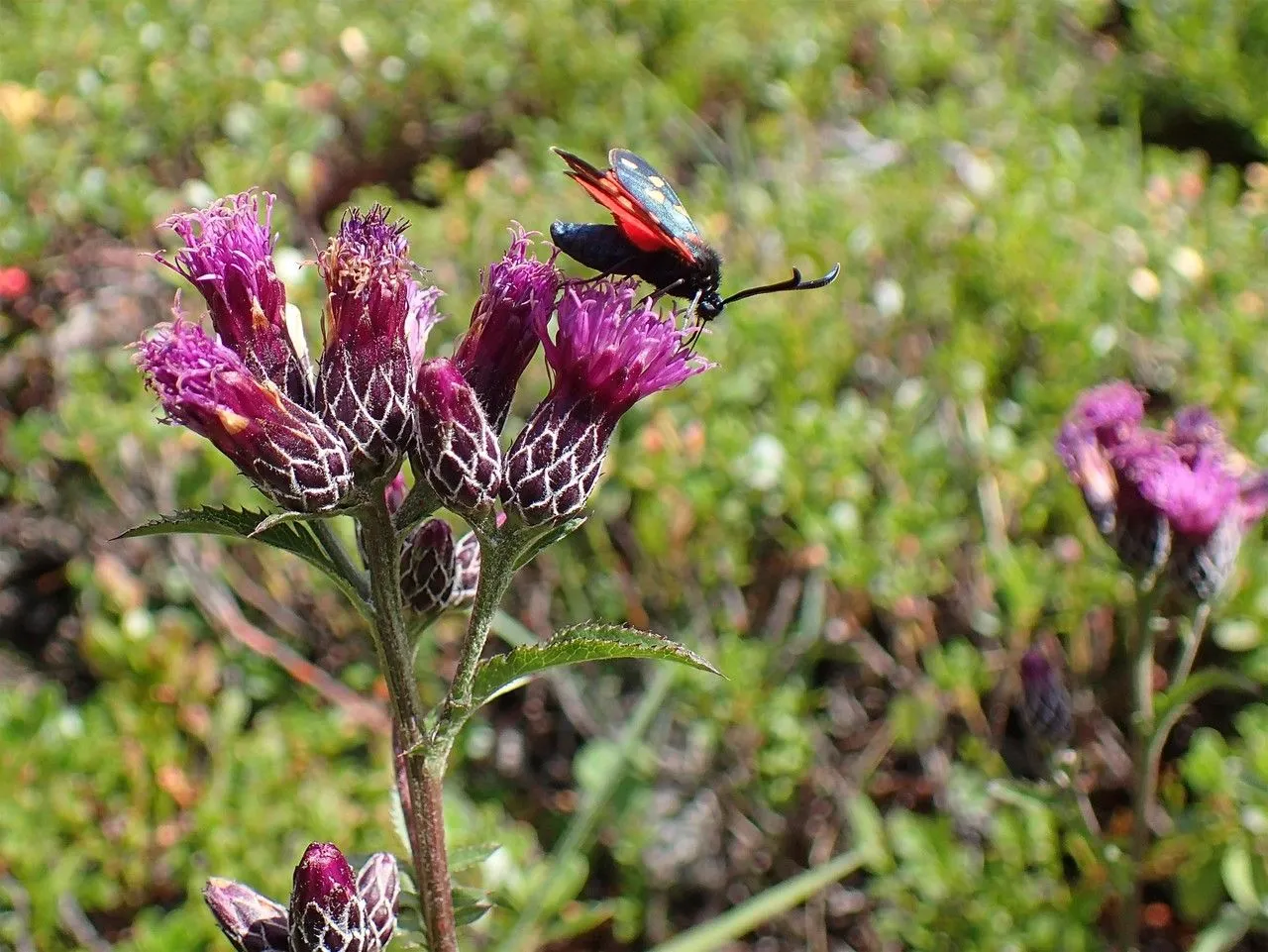
Author: L.
Bibliography: (1753). Sp. Pl. 2
Year: 1753
Status: accepted
Rank: species
Genus: Serratula
Vegetable: False
Observations: Europe to NW. Türkiye
Dyer’s plumeless saw-wort, known scientifically as Serratula tinctoria, is a notable member of the Asteraceae family, a large family of flowering plants. It can be traced back historically to its documentation in 1753, within the seminal work “Species Plantarum” by Carl Linnaeus, who is often referred to by the author abbreviation “L.”
This perennial herb thrives across Europe and extends its reach into the northwestern regions of Türkiye. Characterized by its lack of plumose bracts, which gives it the common name “plumeless,” Serratula tinctoria exhibits a unique, saw-like edge on its leaves, contributing to both its aesthetic and taxonomical classification.
The flowers of Dyer’s plumeless saw-wort are typically clustered in dense, bright purple flower heads that bloom during the summer months, adding a splash of vibrant color to meadows, grasslands, and other natural habitats where it commonly grows. The plant favors sunny locations and well-drained soils but can adapt to various environmental conditions.
Historically, Serratula tinctoria was valued not just for its visual appeal, but also for its utilitarian role in dye production. It was once an essential source of yellow dye, utilized in traditional European textile practices. This dual-purpose use heightened its importance beyond mere ornamental horticulture.
In ecological terms, Dyer’s plumeless saw-wort contributes to the biodiversity of its native regions by offering nectar and pollen to a variety of pollinators, including bees and butterflies. Its presence in a habitat supports the health of the local ecosystem through these interactions.
Conservation efforts and habitat protection are crucial for sustaining both the beauty and biological significance of Serratula tinctoria, ensuring that future generations can continue to appreciate and benefit from this distinguished member of the plant kingdom.
Eng: dyer’s plumeless saw-wort, saw-wort, sawwort
Deu: echte färberscharte, färber-scharte, färberscharte
Dan: eng-skær
Nor: jærtistel
Nob: jærtistel
Nno: jærtistel
Lav: krasu zeltlape
Fra: serratule des teinturiers
Nld: zaagblad
Swe: ängsskära, ängsskärda
Cym: dant y pysgodyn, lliflys, lliflys cyffredin
En: Dyer’s plumeless saw-wort, Saw-wort, Sawwort
Be: Сярпуха фарбавальная
Bg: Щитовиден сърпец
Ca: Serràtula tintòria
Cs: Srpice barvířská
Da: Engskær, Eng-skær
Nl: Zaagblad
Eo: Seratulo tinktura
Et: Värvi-paskhein
Fi: Liuskalääte
Fr: Serratule des teinturiers, Sarrette des teinturiers, Sarrette
De: Färber-Scharte, Färberscharte, Echte Färberscharte, Berg-Scharte, Färber Scharte
Hu: Festő zsoltina
Ga: Sábhlus
It: Cerretta comune, Cerretta dei tintori, Serratola
Lv: Krasu zeltlape
Lt: Geltė
No: Jærtistel
Nb: Jærtistel
Nn: Jærtistel
Pl: Sierpik barwierski
Ru: Серпуха красильная
Sk: Kosienka farbiarska
Es: Serratula
Sv: Ängsskära, Ängsskärda
Cy: Dant y pysgodyn, Lliflys, Lliflys Cyffredin
Taken Jul 15, 2017 by Yoan MARTIN (cc-by-sa)
Taken Jul 15, 2017 by Yoan MARTIN (cc-by-sa)
Taken Jul 20, 2021 by Alain Bigou (cc-by-sa)
Taken Jul 15, 2017 by Yoan MARTIN (cc-by-sa)
Taken Aug 31, 2014 by Tela Botanica − Alain BIGOU (cc-by-sa)
Taken Nov 12, 2022 by henri delozanne (cc-by-sa)
Taken Jul 17, 2019 by margarida vila (cc-by-sa)
Taken Jul 15, 2017 by Yoan MARTIN (cc-by-sa)
Taken Aug 22, 2019 by Maurice PICHINOTY (cc-by-sa)
Taken Jul 12, 2020 by Darren Giddins (cc-by-sa)
Taken Sep 26, 2021 by beurny (cc-by-sa)
Taken Apr 28, 2022 by Marc Gendret (cc-by-sa)
Taken Jul 31, 2014 by Tela Botanica − Yannick DURAND (cc-by-sa)
Taken Aug 14, 2016 by Tela Botanica − Henri SCORDIA (cc-by-sa)
Taken Jul 12, 2020 by Darren Giddins (cc-by-sa)
Taken Oct 16, 2021 by jacques maréchal (cc-by-sa)
Taken Oct 5, 2018 by Robin Cramm (cc-by-sa)
Taken Mar 22, 2021 by Jacques Maréchal (cc-by-sa)
Taken Jul 15, 2017 by Yoan MARTIN (cc-by-sa)
Taken Jul 25, 2020 by huy HO (cc-by-sa)
Taken Jan 1, 1800 by Tela Botanica − Thierry Pernot (cc-by-sa)
Taken Aug 14, 2021 by huy HO (cc-by-sa)
Taken Jul 15, 2017 by Yoan MARTIN (cc-by-sa)
Taken Jul 15, 2017 by Yoan MARTIN (cc-by-sa)
Taken Jul 25, 2020 by huy HO (cc-by-sa)
Taken Jan 1, 1970 by Photoflora – L’Abbé COSTE (©)
Taken Sep 15, 2010 by Photoflora – Benoit BOCK (©)
Taken Jan 1, 1800 by Tela Botanica − Daniel MATHIEU (cc-by-sa)
Taken Jul 31, 1853 by Tela Botanica − Herbier PONTARLIER-MARICHAL (cc-by-sa)
Taken Jul 1, 2012 by Tela Botanica − Marie PORTAS (cc-by-sa)
© copyright of the Board of Trustees of the Royal Botanic Gardens, Kew.
© copyright of the Board of Trustees of the Royal Botanic Gardens, Kew.
© copyright of the Board of Trustees of the Royal Botanic Gardens, Kew.
Growth habit: Forb/herb
Ph maximum: 7.0
Ph minimum: 6.5
Light: 6
Atmospheric humidity: 7
Soil nutriments: 3
Family: Myrtaceae Author: (F.Muell.) K.D.Hill & L.A.S.Johnson Bibliography: Telopea 6: 402 (1995) Year: 1995 Status:…
Family: Rubiaceae Author: Pierre ex A.Froehner Bibliography: Notizbl. Bot. Gart. Berlin-Dahlem 1: 237 (1897) Year:…
Family: Sapindaceae Author: Koidz. Bibliography: J. Coll. Sci. Imp. Univ. Tokyo 32(1): 38 (1911) Year:…
Family: Asteraceae Author: A.Gray Bibliography: Pacif. Railr. Rep.: 107 (1857) Year: 1857 Status: accepted Rank:…
Family: Fabaceae Author: Medik. Bibliography: Vorles. Churpfälz. Phys.-Ökon. Ges. 2: 398 (1787) Year: 1787 Status:…
Family: Aspleniaceae Author: (Cav.) Alston Bibliography: Bull. Misc. Inform. Kew 1932: 309 (1932) Year: 1932…